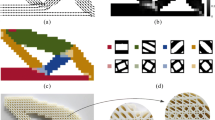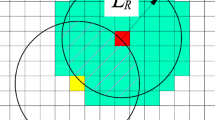Abstract
Microstructural topology optimization (MTO) is the simultaneous optimization of macroscale topology and microscale structure. MTO holds the promise of enhancing product-performance beyond what is possible today. Furthermore, with the advent of additive manufacturing, the resulting multiscale structures can be fabricated with relative ease. There are however two significant challenges associated with MTO: (1) high computational cost, and (2) potential loss of microstructural connectivity. In this paper, a novel density-and-strain-based K-means clustering method is proposed to reduce the computational cost of MTO. Further, a rotational degree of freedom is introduced to fully utilize the anisotropic nature of microstructures. Finally, the connectivity issue is addressed through auxiliary finite element fields. The proposed concepts are illustrated through several numerical examples applied to two-dimensional single-load problems.





















Similar content being viewed by others
References
Alexandersen J, Lazarov BS (2015) Topology optimisation of manufacturable microstructural details without length scale separation using a spectral coarse basis preconditioner. Comput Meth Appl Mech Eng 290(290):156–182. arXiv:1411.3923
Allaire G, Aubry S (1999) On optimal microstructures for a plane shape optimization problem. Structural Optimization 17(2):86–94
Allaire G, Geoffroy-Donders P, Pantz O (2018) Topology optimization of modulated and oriented periodic microstructures by the homogenization method. Computers and Mathematics with Applications
Arthur D, Vassilvitskii S (2007) K-means++: the advantages of careful seeding. Proceedings of the eighteenth annual ACM-SIAM symposium on Discrete algorithms, pp 1027–1025. arXiv:1212.1121
Avellaneda M (1987) Optimal bounds and microgeometries for elastic two-phase composites. Siam J Appl Math 47(6):1216–1228
Bendsøe MP (1989) Optimal shape design as a material distribution problem. Structural Optimization 1 (4):193–202
Bendsøe MP, Kikuchi N (1988) Generating optimal topologies in structural design using a homogenization method. Comput Methods Appl Mech Eng 71(2):197–224
Bendsøe MP, Sigmund O (1999) Material interpolation schemes in topology optimization. Arch Appl Mech 69(9-10):635–654
Bendsøe MP, Sigmund O (2004) Topology optimization. Springer, Berlin
Bendsøe MP, Guedes JM, Haber RB, Pedersen P, Taylor JE (1994) An analytical model to predict optimal material properties in the context of optimal structural design. J Appl Mech 61(4):930
Coelho PG, Fernandes PR, Guedes JM, Rodrigues HC (2008) A hierarchical model for concurrent material and topology optimisation of three-dimensional structures. Struct Multidiscip Opt 35(2):107–115
Cramer AD, Challis VJ, Roberts AP (2016) Microstructure interpolation for macroscopic design. Struct Multidiscip Optim 53(3):489–500
Deng J, Chen W (2017) Concurrent topology optimization of multiscale structures with multiple porous materials under random field loading uncertainty. Struct Multidiscip Optim 56(1):1–19
Deng S, Suresh K (2015) Multi-constrained topology optimization via the topological sensitivity. Struct Multidiscip Optim 51(5):987–1001
Deng S, Suresh K (2017) Stress constrained thermo-elastic topology optimization with varying temperature fields via augmented topological sensitivity based level-set. Structural and Multidisciplinary Optimization 56(6):1413–1427
Deng J, Yan J, Cheng G (2013) Multi-objective concurrent topology optimization of thermoelastic structures composed of homogeneous porous material. Struct Multidiscip Optim 47(4):583–597
Du Z, Zhou X, Picelli R, Kim HA (2018) Connecting microstructures for multiscale topology optimization with connectivity index constraints. J Mech Des 140(11):111417
Ferrer A, Cante JC, Hernández JA, Oliver J (2017) Two-scale topology optimization in computational material design: an integrated approach. Int J Numer Methods Eng 114:232–254
Francfort GA, Murat F (1986) Homogenization and optimal bounds in linear elasticity. Arch Ration Mech Anal 94(4):307–334
Gao W, Zhang Y, Ramanujan D, Ramani K, Chen Y, Williams CB, Wang CCL, Shin YC, Zhang S, Zavattieri PD (2015) The status, challenges, and future of additive manufacturing in engineering. CAD Computer Aided Design 69:65–89
Groen JP, Sigmund O (2018) Homogenization-based topology optimization for high-resolution manufacturable microstructures. Int J Numer Methods Eng 113(8):1148–1163
Groen JP, Wu J, Sigmund O (2019) Homogenization-based stiffness optimization and projection of 2D coated structures with orthotropic infill. Computer Methods in Applied Mechanics and Engineering
Hassani B, Hinton E (1998) A review of homogenization and topology optimization i - homogenization theory for media with periodic structure. Comput Struct 69(6):707–717
Hashin Z, Shtrikman S (1962) A variational approach to the theory of the elastic behaviour of polycrystals. J Mech Phys Solids 10(4):343–352
Huang X, Radman A, Xie YM (2011) Topological design of microstructures of cellular materials for maximum bulk or shear modulus. Comput Mater Sci 50(6):1861–1870. arXiv:0702674v1
Huang X, Zhou SW, Xie YM, Li Q (2013) Topology optimization of microstructures of cellular materials and composites for macrostructures. Comput Mater Sci 67:397–407
Jog CS, Haber RB, Bendsøe MP (1994) Topology design with optimized, self-adaptive materials. Int J Numer Meth Eng 37(8):1323–1350
Kočvara M, Stingl M, Zowe J (2008) Free material optimization: recent progress. Optimization 57 (1):79–100
Li H, Luo Z, Gao L, Qin Q (2018) Topology optimization for concurrent design of structures with multi-patch microstructures by level sets. Comput Methods Appl Mech Eng 328:340–364
Liu ST, Cheng GD, Gu Y, Zheng XG (2002) Mapping method for sensitivity analysis of composite material property. Struct Multidiscip Optim 24(3):212–217
Liu L, Yan J, Cheng G (2008) Optimum structure with homogeneous optimum truss-like material. Comput Struct 86(13-14):1417–1425
Liu C, Du Z, Zhang W, Zhu Y, Guo X (2017) Additive manufacturing-oriented design of graded lattice structures through explicit topology optimization. J Appl Mech 84(8):081008
Liu K, Detwiler D, Tovar A (2018a) Cluster-based optimization of cellular materials and structures for crashworthiness. J Mech Des 140(11):111412
Liu J, Gaynor AT, Chen S, Kang Z, Suresh K, Takezawa A, Li L, Kato J, Tang J, Wang CC, Cheng L, Liang X, To AC (2018b) Current and future trends in topology optimization for additive manufacturing. Struct Multidiscip Opt 57(6):2457–2483
Lloyd SP (1982) Least squares quantization in PCM. IEEE Trans Inf Theory 28(2):129–137
Milton GW, Cherkaev AV (1995) Which elasticity tensors are realizable? J Eng Mater Technol 117(4):483
Nakshatrala PB, Tortorelli DA, Nakshatrala KB (2013) Nonlinear structural design using multiscale topology optimization. Part I: Static formulation. Comput Meth Appl Mech Eng 261-262:167–176
Novotny AA, Feijóo RA, Taroco E, Padra C (2003) Topological sensitivity analysis. Comput Methods Appl Mech Eng 192(7-8):803–829
Osanov M, Guest JK (2016) Topology optimization for architected materials design. Annu Rev Mater Res 46(1):211–233
Pantz O, Trabelsi K (2008) A post-treatment of the homogenization method for shape optimization. SIAM J Control Optim 47(3):1380–1398
Pedersen P (1989) On optimal orientation of orthotropic materials. Structural Optimization 1(2):101–106
Rodrigues HC, Guedes JM (2002) Hierarchical optimization of material and structure. Struct Multidiscip Opt 24(1):1–10
Schury F, Stingl M, Wein F (2012) Efficient two-scale optimization of manufacturable graded structures. SIAM J Sci Comput 34(6):B711–B733. arXiv:1309.5548v1
Sethian JA, Wiegmann A (2000) Structural boundary design via level set and immersed interface methods. J Comput Phys 163(2):489–528. arXiv:1011.1669v3
Sigmund O (1994) Materials with prescribed constitutive parameters: an inverse homogenization problem. Int J Solids Struct 31(17):2313–2329
Sigmund O (2000) New class of extremal composites. J Mech Phys Solids 48(2):397–428
Sigmund O (2001) A 99 line topology optimization code written in matlab. Struct Multidiscip Optim 21 (2):120–127
Sigmund O (2007) Morphology-based black and white filters for topology optimization. Struct Multidiscip Optim 33(4-5):401–424
Sigmund O, Maute K (2013) Topology optimization approaches: a comparative review. Struct Multidiscip Optim 48(6):1031–1055
Sigmund O, Torquato S (1997) Design of materials with extreme thermal expansion using a three-phase topology optimization method. J Mech Phys Solids 45(6):1037–1067
Sigmund O, Aage N, Andreassen E (2016) On the (non-)optimality of Michell structures. Struct Multidiscip Optim 54(2):361–373
Sivapuram R, Dunning PD, Kim HA (2016) Simultaneous material and structural optimization by multiscale topology optimization. Struct Multidiscip Optim 54(5):1267–1281
Vigdergauz SB (1989) Regular structures with extremal elastic properties. Mechanics of Solids 24(3):57–63
Vigdergauz S (1994) Two-dimensional grained composites of extreme rigidity. J Appl Mech 61(2):390
Vogiatzis P, Chen S, Wang X, Li T, Wang L (2017) Topology optimization of multi-material negative poisson’s ratio metamaterials using a reconciled level set method. CAD Computer Aided Design 83:15–32
Wang M, Wang X, Guo D (2003) A level set method for structural topology optimization. Comput Methods Appl Mech Eng 192(1-2):227–246
Wang Y, Chen F, Wang MY (2017a) Concurrent design with connectable graded microstructures. Comput Methods Appl Mech Eng 317:84–101
Wang Y, Xu H, Pasini D (2017b) Multiscale isogeometric topology optimization for lattice materials. Comput Methods Appl Mech Eng 316:568–585
Xie YM, Steven GP (1993) A simple evolutionary procedure for structural optimization. Comput Struct 49(5):885–896
Xie YM, Yang X, Shen J, Yan X, Ghaedizadeh A, Rong J, Huang X, Zhou S (2014) Designing orthotropic materials for negative or zero compressibility. Int J Solids Struct 51(23-24):4038–4051
Xu L, Cheng G (2018) Two-scale concurrent topology optimization with multiple micro materials based on principal stress orientation. Struct Multidiscip Optim 57(5):2093–2107
Yan X, Huang X, Zha Y, Xie YM (2014) Concurrent topology optimization of structures and their composite microstructures. Comput Struct 133:103–110
Yang XY, Xei YM, Steven GP, Querin OM (1999) Bidirectional evolutionary method for stiffness optimization. AIAA J 37(11):1483–1488
Zhang W, Sun S (2006) Scale-related topology optimization of cellular materials and structures. Int J Numer Methods Eng 68(9):993–1011
Zhang Y, Xiao M, Li H, Gao L, Chu S (2018) Multiscale concurrent topology optimization for cellular structures with multiple microstructures based on ordered SIMP interpolation. Comput Mater Sci 155:74–91
Zhou S, Li Q (2008) Design of graded two-phase microstructures for tailored elasticity gradients. J Mater Sci 43(15):5157–5167
Zhu Y, Li S, Du Z, Liu C, Guo X, Zhang W (2019) A novel asymptotic-analysis-based homogenisation approach towards fast design of infill graded microstructures. J Mech Phys Solids 124:612–633
Funding
The authors would like to thank the support of the National Science Foundation through grant 1561899. Prof. Krishnan is a consulting Chief Scientific Officer of SciArt, Corp, which has licensed the Pareto technology, developed in Prof. Suresh’s lab, through Wisconsin Alumni Research Foundation.
Author information
Authors and Affiliations
Corresponding author
Ethics declarations
Conflict of interests
The authors declare that they have no conflict of interest.
Additional information
Responsible Editor: Ole Sigmund
Publisher’s note
Springer Nature remains neutral with regard to jurisdictional claims in published maps and institutional affiliations.
Rights and permissions
About this article
Cite this article
Kumar, T., Suresh, K. A density-and-strain-based K-clustering approach to microstructural topology optimization. Struct Multidisc Optim 61, 1399–1415 (2020). https://doi.org/10.1007/s00158-019-02422-4
Received:
Revised:
Accepted:
Published:
Issue Date:
DOI: https://doi.org/10.1007/s00158-019-02422-4




